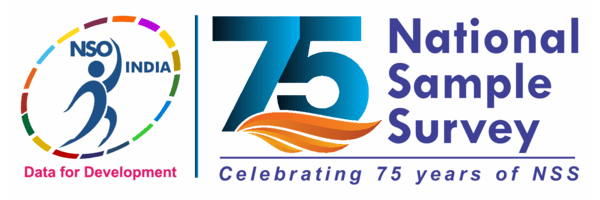DDI-IND-MOSPI-NSS-HCES23-24
Household Consumption Expenditure Survey: 2023-24
| Name |
|---|
| INDIA |
The National Sample Surveys (NSS) are being conducted by the Government of India since 1950 to collect socio-economic data employing scientific sampling methods. Household Consumption Expenditure Survey 2023-24 will commence from August 2023.
The Household Consumption Expenditure Survey (HCES) is designed to collect information on consumption of goods and services by the households. Information collected in HCES is used for analyzing and understanding the consumption and expenditure pattern, standard of living and well-being of the households. Besides, the data of the survey provides budget shares of different commodity groups that is used for preparation of the weighting diagram for compilation of official Consumer Price Indices (CPIs). The data collected in HCES is also utilized for deriving various other macroeconomic indicators.
8,684 FSUs in the rural areas and 6,143 in the urban areas have been surveyed in HCES:2023-24. The total sample size of 14,827FSUs has been allocated to State/UTs in proportion to Census 2011 population, subject to a minimum allocation of 40 FSUs.
| Name | Affiliation |
|---|---|
| NSS | MoSPI |
| Name | Affiliation |
|---|---|
| DIID | M/o STATISTICS & PROGRAMME IMPLEMENTATION |
| Name |
|---|
| M/o STATISTICS & PROGRAMME IMPLEMENTATION |
The latest survey on household consumption expenditure (previously known as household consumer expenditure survey) was conducted during the period August 2023 to July 2024 in which information was collected from each sampled household in three questionnaires, namely, Questionnaire: FDQ (Food Items), Questionnaire: CSQ (Consumables & Services) and Questionnaire: DGQ (Durable Items) in three separate monthly visits in a quarter. Apart from these, another questionnaire, namely, Questionnaire: HCQ was canvassed to collect information on household characteristics.
In HCES: 2023-24, a multi-stage stratified sampling design was used where villages/urban blocks or sub-units of these were regarded as the First Stage Units (FSU) and the households were the Ultimate Stage Units (USU). Both the FSUs and USUs were selected with Simple Random Sampling Without Replacement (SRSWOR). 18 sample households were canvassed within an FSU.
The survey period of HCES:2023-24was divided into 10 panels, each consisting of three months. In the first month of any panel,Questionnaire: HCQ along with any one of the questionnaires, i.e., FDQ/CSQ/DGQwere canvassed in the selected households. During the second month of the panel, any one from the remaining two questionnaires was canvassed and in the last month, the last questionnaire was canvassed. The sequence of the questionnaires to be canvassed in each month of a panel for a particular FSU was decided randomly to eliminate bias that may arise due to the adoption of a particular sequencing for canvassing. Thus, all six possible sequences, i.e., [(Q1, Q2, Q3), (Q1, Q3, Q2), (Q2, Q1, Q3), (Q2, Q3, Q1), (Q3, Q1, Q2) and (Q3, Q2, Q1)], where Q1 refers to FDQ, Q2 refers to CSQ and Q3 refers to DGQ, were canvassed at random in the sample households.
The sampling frame for urban sector is the list of Urban Frame Survey (UFS) blocks as per latest Urban Frame Survey and for rural sector, it is the list of villages as per Census 2011 updated by removing those villages which are urbanized and included in latest UFS (till the time of sample selection).Sometimes, with a view to ensure uniformity in the size of FSUs and operational convenience, large villages/UFS blocks are notionally divided into smaller units of more or less equal size, known as sub-units depending on a pre-defined criteria based on population in the village or number of households in the UFS block. The sector-specific criteria for sub-unit formation are as below:
Rural Sector
(i) The number of SUs to be formed in the villages (with Census 2011 population of 1000 or more and except some States/UTs) are decided based on projected present population of the village. The criteria aregiven below:
Projected Population of the village No. of SUs to be formed
less than 1200 1
1200 to 2399 2
2400 to 3599 3
… …
(ii) For rural areas of Himachal Pradesh, Sikkim, Andaman & Nicobar Islands, Ladakh, Parts of Uttarakhand (except four districts Dehradun, Nainital, Haridwar and Udham Singh Nagar), Jammu and Kashmir (seven districts Poonch, Rajouri, Udhampur, Reasi, Doda, Kishtwar, Ramban) and Idukki district of Kerala; SU is formed in a village if population as per Census 2011 is more than or equals to 500. The criteria for the number of SU to be formed are as below:
Projected Population of the village Number of SUs to be formed
less than 600 1
600 to 1199 2
1200 to 1799 3
... ...
Urban Sector:
(i) SUs are formed in those UFS blockshaving more than or equal to 250 households. The number of SUs to be formed within the UFS blocks is decided by the following criteria:
Number of Households in UFS Block Number of SUs to be formed
less than 250 1
250 to 499 2
500 to 749 3
… …
Thus, the list of Villages / UFS Blocks / Sub-Units (for those villages or UFS blocks where sub-units are formed within) together formed the sampling frame for First Stage Unit selection.
DDI-IND-MOSPI-NSS-HCES23-24
| Name | Affiliation | Role |
|---|---|---|
| DIID | M/o STATISTICS & PROGRAMME IMPLEMENTATION | DOCUMENTATION OF THE STUDY |
2025-04-16

